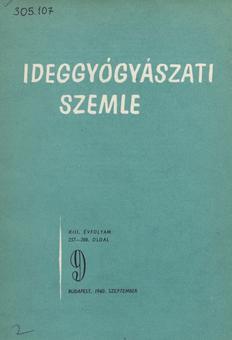The eLitMed.hu medical portal uses computer cookies for convenient operation. Detailed information can be found in the Cookie-policy.
Clinical Neuroscience - 1960;13(09)
Content
[On pial vascular lesions in perinatal polycystic brain lesions]
[Authors describe pial arterial lesions in four infants and children with perinatal brain injury that narrowed the lumen by subintimal tissue proliferation in a portion of the arteries. They address the pathogenesis of this phenomenon on the basis of their own studies and the literature and consider the vascular lesion to be a secondary phenomenon associated with brain lesions, a consequence of adaptation to reduced blood circulation. ]
[Critique of ataraxis]
[There are important differences between the effects of neuroleptics and ataractics ; the former can have a qualitative effect on psychotic experiences and the structure of psychosis, the latter only a quantitative effect. Therapeutic results are favourable in a significant proportion of cases, but the improvement achieved is only a measure of the complex and dynamic nature of the remission process. In discussing the manifestations of anxiety and tension within normal psychological limits, the role of nociceptive emotional signalling and negative emotional experiences in guiding adaptation and the not always rational and often detrimental nature of their ataractivation has been highlighted. Certain abnormal personalities show a particular tendency to abuse tranquilizers. Among the psychopathological conditions of habituation, we attribute the main role to the "euphoria of soulagement" and to coenaesthesia hypersensitivity, which is a major responsibility of doctors who superficially simplify the treatment of "nervous people". The proliferation of tranquilliser prescriptions, which are intended to replace psychotherapy, could be a serious danger and we have therefore stressed the primacy of psychotherapy in many cases. Our main task: to guide, guide and support patients in conflict situations and with weakened adaptive capacities to resolve and rationally and correctly process their morbid experience or conflict situation. In this endeavour, ataractics can be a valuable 'adjuvant' if used with due care and proper medical criticism.]
[Electroencephalographic image of mental stress-activated pyknolepsy]
[1. We investigated the effect of mental strain on our case of pyknolepsy recorded in the eeg. For applied stress, electrical activity was altered, with high amplitude, sustained, slow 3/s activity. 2. The more prolonged application of stimuli and the increase in the intensity of the stress led to the appearance of typus petit mai. 3. The phenomenon was reproducible after a longer period of time and a direct correlation between the applied stress, the change in activity and the onset of seizure could be established. ]
[The relationship between neuroses and psychoses]
[It can be said that a lecture on the relationship between neuroses and psychoses can raise many new and old aspects, but only without the final conclusios. We cannot present definite facts in a systematic way, - but perhaps we can see more clearly that what is needed is not so much a new delineation of neurological and psychiatric pathologies, but rather the discovery and separation of the dynamic pathomechanistic factors - some general and common , some different from individual to individual - underlying mental illness. Different paths can be chosen to achieve this goal, but which of these best achieves or approaches the major theoretical and practical problems, only the future will tell. The literature is very large in number, given the wide-ranging nature of the subject.]
[Psychotherapy for neurosis in patients with aphasia]
[The neurosis of an aphasia patient, which developed as a result of psychotrauma caused by aphasia, was treated with hypnosis. On hypnosis, the neurosis was cured and the aphasic disturbances improved to such an extent that our patient was able to resume his original occupation. The use of hypnosis with a newer technique, when performed on the basis of ponto indicatio, gives good results in cases where even treatment with neuroleptic drugs is ineffective. ]
1.
Clinical Neuroscience
[Headache registry in Szeged: Experiences regarding to migraine patients]2.
Clinical Neuroscience
[The new target population of stroke awareness campaign: Kindergarten students ]3.
Clinical Neuroscience
Is there any difference in mortality rates of atrial fibrillation detected before or after ischemic stroke?4.
Clinical Neuroscience
Factors influencing the level of stigma in Parkinson’s disease in western Turkey5.
Clinical Neuroscience
[The effects of demographic and clinical factors on the severity of poststroke aphasia]1.
2.
3.
4.
5.



